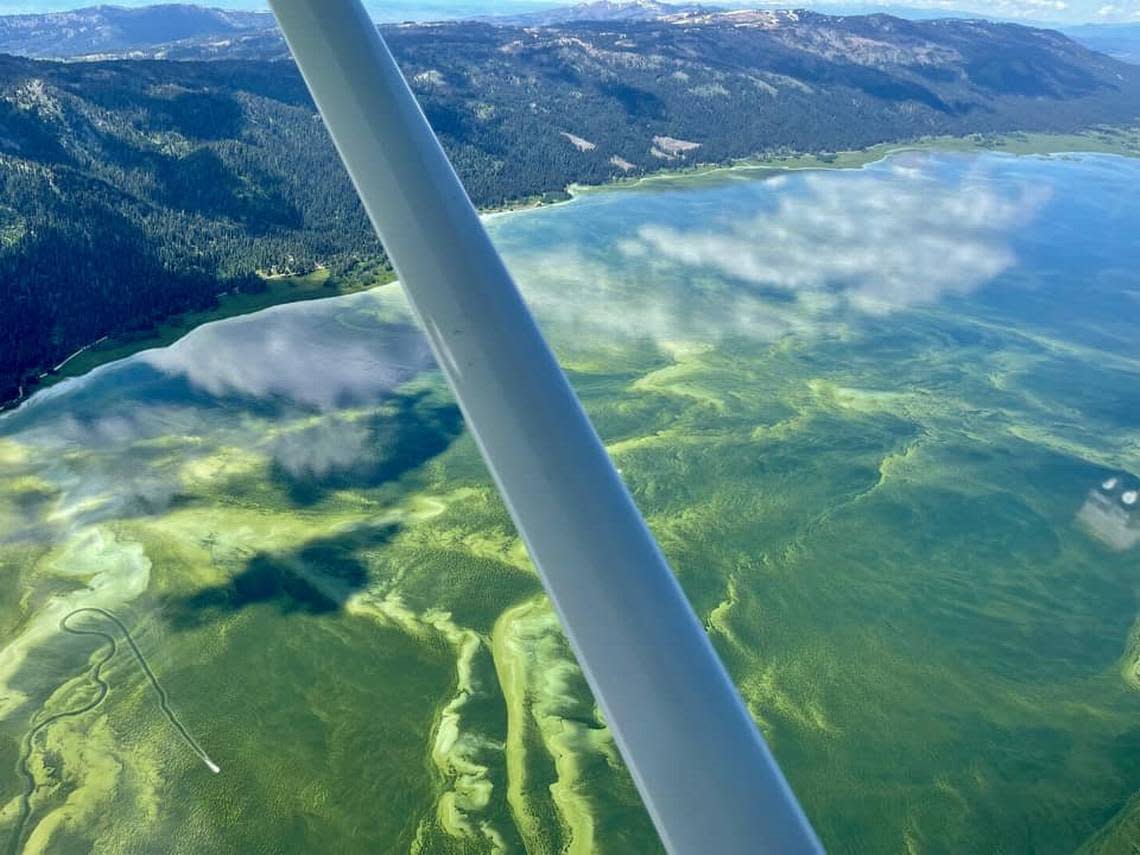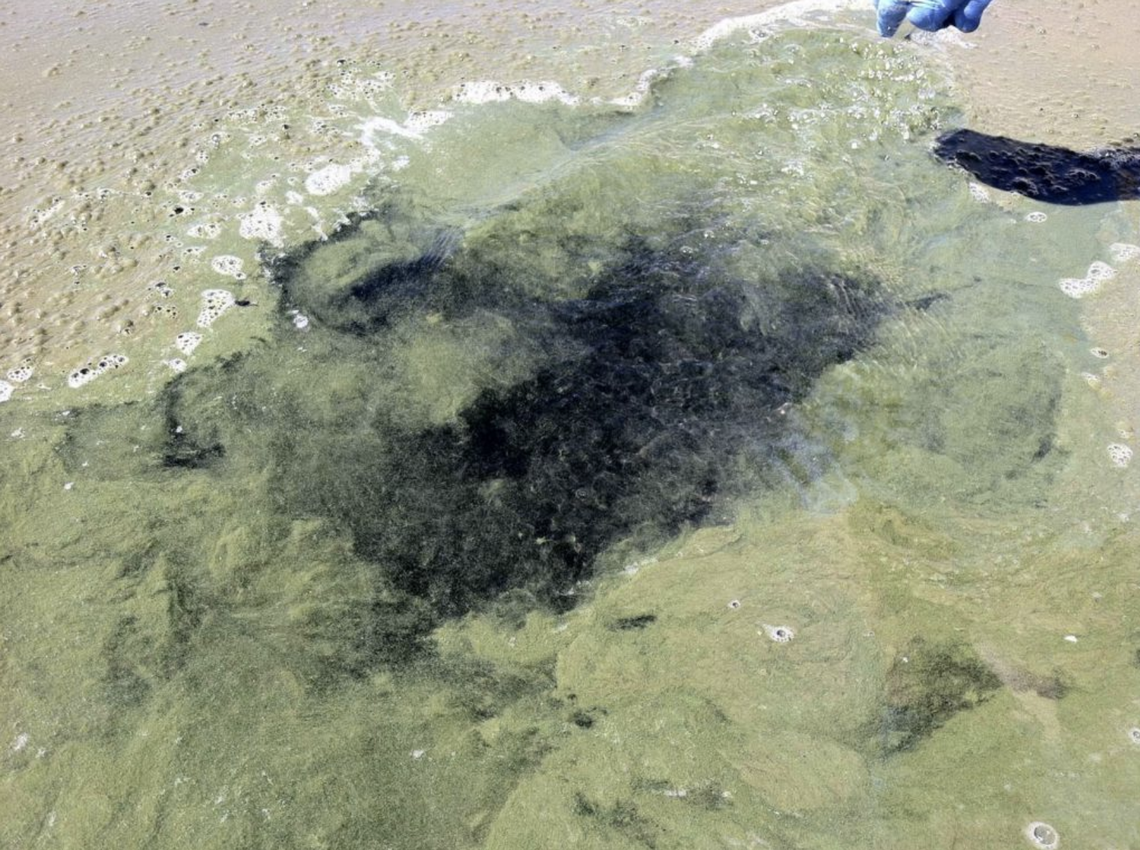Jump in, the water’s warm and toxic. Idaho is used to algae wars. How about this summer?
Harmful algae blooms are a persistent problem worldwide, and throughout Idaho, where they strike every summer.
These blooms, often vivid cyan and emerald, are caused by cyanobacteria, a type of algae that can produce cyanotoxins. If present in high enough concentrations, they can threaten aquatic ecosystems, our health and the health of pets.
“It’s very naturally occurring in systems,” said Elizabeth Spelsberg, senior water quality standards scientist at the Idaho Department of Environmental Quality, in a phone interview with the Idaho Statesman. “We’ve had cyanobacteria in Lake Cascade since we’ve started monitoring in the ‘70s.”
Three of the state’s big water bodies — Brownlee Reservoir, Hells Canyon and Salmon Falls Creek Reservoir — have been under a public health advisory for harmful algae blooms (HAB) because they’ve surpassed the 2019 EPA thresholds for human health, putting the summer algae bloom season in full swing — even though Lake Cascade and Boise-area ponds have avoided the algae wars so far.
“It’s scary,” admitted Spelsberg, who noted a recent uptick in calls from the public inquiring about the safety of some Idaho lakes and reservoirs in the dead of the August heat.
Not all algae are harmful
Algae can be a beneficial part of natural environments. Tyler King, a research hydrologist for the Idaho Water Science Center, explained in a phone interview that “we see multiple types of blooms in these systems,” but only a few are harmful.
For instance, oftentimes in the West a different, harmless type of algae called diatoms will peak within aquatic systems over winter and early spring. Diatoms are “mostly benign, as in they do not produce toxins,” and their silica shells are often really beautiful under a microscope, King said.
The algae of concern, called cyanobacteria, typically ramp up in July and August and last until October, November or even December, depending on water temperatures, according to King. The hotter the summer, the later into the year the risk is likely.
The most common cyanotoxins in Idaho and the U.S. are microcystins, a group of liver toxins that can cause gastrointestinal illness in humans, pets, livestock and wildlife.
Dogs and cows are particularly susceptible, partly because they’re more likely to drink or swim in the affected water. “And then when they come out to lick their fur, that’s one way that they can get a dose of cyanotoxins,” King said.
But the other reason certain animals are more sensitive to these blooms is the diversity of neurological pathways. “If it’s a neurotoxin, it can affect some species differently,” according to King.
Cyanobacteria are also harmful to the fish and other marine life in aquatic systems since they suck oxygen out of the water. When these algae die, they settle down the water column to be decomposed by bacteria, and that decomposition consumes oxygen.
“Fish co-evolved with cyanobacteria, so they’re not actually susceptible to the toxins that cyanobacteria produce. But they are very susceptible to the lack of oxygen that often comes with an algal bloom,” King said.
There are several types of cyanotoxins, including those that affect the liver, nerves and skin, which all in turn have important implications for human and animal health.

Designing better ways to detect harmful blooms
Historically, monitoring and tracking HABs has relied on in-person reports submitted by the public. But a publication from late last year demonstrated that satellite imagery can be used to identify bodies of water with high chlorophyll, more than 10 micrograms per liter.
“We use chlorophyll because it’s a colored pigment,” able to be seen from space, King said.
The green of the chlorophyll is a pretty good proxy for cyanobacteria. But the problem is that lots of other things can be green. So it’s important to combine that data with an ecological understanding of how these systems typically function.
For example, if there is a spike in chlorophyll in the wintertime, or even in the spring, that probably is not cyanobacteria. And if there is a persistent patch of high chlorophyll, “present from week to week to week to week,” and it’s near a shallow part of the reservoir, it’s probably submerged aquatic vegetation and not a sign of cyanobacterial bloom, according to King.
But if you were to witness a large increase in chlorophyll over a large portion of a body of water in the summertime, “especially if it has spatial patterns that look like it’s swirling and moving with the currents,” there’s “reasonable certainty that you’re looking at a cyanobacteria bloom,” King said.
That information is useful for state agencies to identify which lakes may be unsuitable for swimming and which areas within that water body could have the highest concentrations of cyanotoxins.
Using this tool provides “a better way to narrow down where to go sample water,” Spelsberg said.
Cozy conditions for cyanobacteria
According to King, cyanobacteria crave three things: warmth, sun and food.
For food, these microorganisms consume nitrogen and phosphorus. A lot of cyanobacteria are able to fix up their own nitrogen from the atmosphere, so often their limiting nutrient is phosphorus.
There are many sources of phosphorus in the environment, including fertilizers, human wastewater, the atmospheric deposition of dust particles and runoff after wildfires. Spelsberg said a large fire on the west side of Lake Cascade contributed to more bare soil and higher rates of runoff into the water.
Making sure the harmful cyanobacteria don’t have everything they need to thrive in water is probably the most effective way to deal with their toxic punches, but this management strategy can be difficult to implement in practice, and there are presently few active efforts aimed at directly preventing blooms in Idaho and elsewhere.
As one example, when a series of water quality issues, including cyanobacteria, caused Esther Simplot Park’s ponds to close in 2018, the city of Boise installed an aeration system and changed the flow of water through Quinn’s Pond and Esther Simplot ponds to address the issue, according to King.
Prevention is definitely the “less sexy” strategy. If you talk to someone about “total daily maximum load planning” and “meeting all the water quality standards within a watershed upstream of lakes and reservoirs,” as Spelsberg covered in her phone interview with the Statesman, people’s eyes tend to glaze over.
But prevention is key and “controlling the input into the system is where I think we can make a difference,” Spelsberg said.
That said, a growing field of research is focused on methods and technologies to control or suppress blooms.

Can we spot and stop a harmful algae bloom?
Throughout the years, many technologies and techniques have been developed for addressing the issue of harmful blooms in water — after they’ve already developed.
But there also has been extensive work by scientists and researchers to be pre-emptive, and a lot of progress has been made.
In the early 2000s, NOAA funded studies to test the use of clays that, when dispersed into the ocean, could bind with both algae and their toxins, and sink them to the ocean floor to be buried.
In 2002, a material called Lanthanum-modified bentonite, commercially called Phoslock, was developed by the CSIRO in Australia. Since then it has been widely applied in more than 200 freshwater systems worldwide to manage eutrophication by absorbing phosphorous and settling it to the bottom, which starves cyanobacteria and effectively prevents explosive growth.
In 2018, engineers at Nano Air Bubble Aeration System Technology tested a way to use nanobubbles (bubbles smaller than the width of a single human hair) to aerate water bodies and dissolve harmful algae.
In 2021, researchers developed a chemical control agent isolated from the bacterium Shewanella that can halt the growth of some HABs with minimal effects on common non-target organisms.
We are still getting closer every year to a cure for cyanoHABs, scientists say. Just last month, researchers released the design of a floating sponge that features a powdered biochar from shrimp cells that can inactivate more than 85% of algal cells.
All of these breakthroughs, especially when merged with thoughtful water management, have the potential to someday permanently solve one of the most persistent and pervasive threats to aquatic systems.
Julie Jung is an American Association for the Advancement of Science fellow working with the Idaho Statesman this summer. She has degrees from Williams College (B.A.) in Massachusetts and Boston University (M.A. and Ph.D.), and is doing postdoctoral work at the University of Utah. Reach her at jjung@idahostatesman.com .
